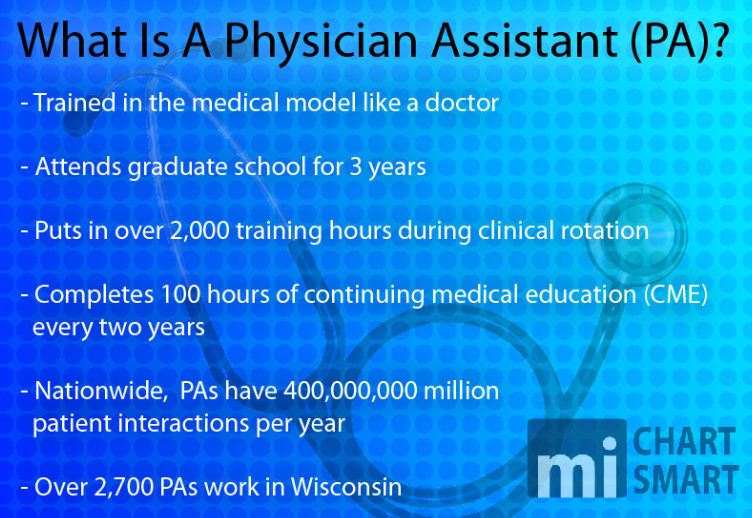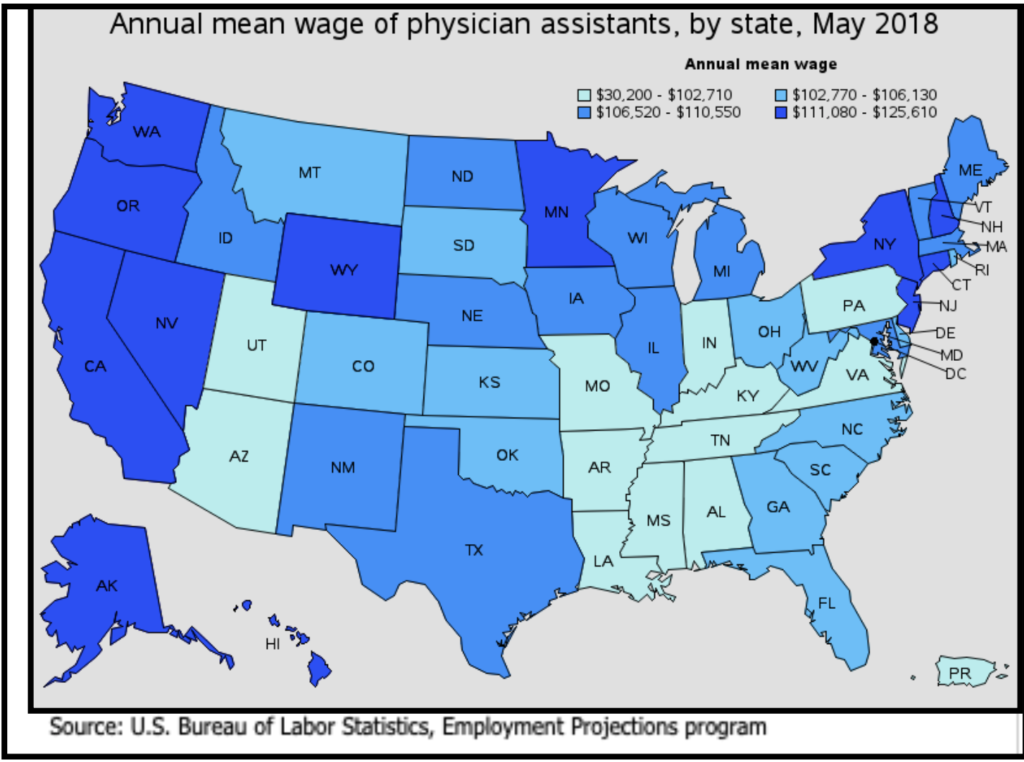
Research shows that the modern PA provides high quality, cost effective and accessible care for their patients
Reforming Health Care In Wisconsin: First In A Series
Executive Summary
-
- As we continue to search for new ways to lower the cost of and expand access to health care across the country and in Wisconsin, one idea that warrants consideration is to modernize the way a Physician Assistant, or PA as they are commonly known, can practice medicine.
-
- An outdated regulation system arbitrarily restricts how and when a PA can practice.
-
- A PA is a highly educated and trained medical care provider who works with physicians and other health care professionals to deliver quality care for their patients.
-
- Currently in Wisconsin, a PA is licensed to provide care only with “the supervision and direction of a physician.” Essentially, in order for a PA to treat a patient in Wisconsin, the PA is required to practice under the general supervision of a physician. Wisconsin law also requires that one physician may supervise no more than four PAs.
-
- This restricts the number of PAs practicing in Wisconsin and the number of patients they treat, limiting access to care.
-
- If Wisconsin followed the lead of other states by switching to a collaboration model and modernized our PA license requirements, Wisconsinites will receive more high-quality health care at a lower cost, especially in our underserved rural and urban areas.
Introduction
A Physician Assistant (PA) is a medical care provider who diagnoses illness, develops treatment plans and prescribes medications, working with physicians and other health care professionals in a collaborative team setting to treat a patient. The PA profession was established in 1967 and today the PA is a vital part of our modern health care system. There are over 123,000 practicing PAs in the United States and 2,700 in Wisconsin.
The education requirements for a PA are extensive and rigorous. A PA is trained in the medical model like a doctor, goes to graduate school for 3 years and puts in over 2,000 training hours in a clinical rotation. A PA candidate must pass a national certifying examination to be licensed to practice and must complete 100 hours of continuing medical education every two years in order to continue treating patients.
Michigan, Minnesota and Illinois have modernized their PA laws and each state has more board-certified PAs than Wisconsin.
Despite all of this education and training, currently in Wisconsin, a PA is licensed to provide care only under the supervision and direction from a physician. That means a PA must have a written agreement with every doctor they work with, that doctor must be available at all times for possible consultation and there is a limit on the number of PAs one physician may supervise. This inconvenient and bureaucratic system is unrealistic in today’s health care system that requires flexibility and cooperation.
PAs are licensed and regulated by the Medical Examining Board, which is comprised of ten physicians and three public members. Other non-physician professions, like nurses and dentists, have their own governing and licensing boards in Wisconsin. PAs do not.
Midwestern states like Michigan, Minnesota and Illinois have modernized their laws to reflect that the PA/Physician relationship is about collaboration among health care professionals, not the supervision of a subordinate. Both Michigan and Illinois no longer require PAs to be supervised by physicians – instead allowing for a collaborative relationship – and Minnesota and Michigan do not limit the number of PAs with whom a physician may practice.
Clearly, we need to do whatever is necessary to encourage more PAs to work in Wisconsin.
The Problem
Doctors today do not want to be legally responsible and liable for the care given by another medical professional and that is a big problem with the current arrangement. A PA should be responsible for the quality of care he or she provide their patients. It should not be the responsibility of doctors or any other medical professionals.
The model that a PA needs to be assigned to a doctor and become the responsibility of that doctor is archaic and unnecessary. When the PA profession was created back in the 1960s, there may have been a justification to have a doctor in an official supervisory role but not today. PAs undergo so much education and clinical training on their own nowadays that they do not need a doctor to show them the ropes or watch over their shoulders.
It is important to note that in states that have modernized the PA-Doctor relationship, the role of the PA has not fundamentally changed or expanded. Some critics may try to characterize this change as an attempt to grab more power or take critical responsibilities away from a physician but the research from other states shows that to be untrue.
PAs Will Lower the Cost of Health Care By Increasing Access
It is not a secret that the country and our health care system will be facing a critical shortage of doctors in the near future. The Association of American Medical Colleges believes the country will experience a shortage of up to 190,000 physicians by 2032. PAs will play a large part in filling that void. The U.S. Bureau of Labor Statistics projects a robust 31% growth in employment for PAs between now and 2028. By comparison, the growth of other similar medical professions is projected at just 13%. Wisconsin risks losing out on this projected growth of PAs to neighboring states if we do not make any changes and continue to accept the status quo.
In some parts of the country, the medical care crisis is here. More than 56% of all rural counties in the country do not have a pediatrician (Rural and Minority Health Research Center, https://www.ruralhealthresearch.org/recaps/9). If such a large geographical area like a county is without a pediatrician, health care consumers suffer and costs increase. Non-physician professionals like PAs will clearly need to be part of the solution to this crisis.
We see this shortage already in parts of Wisconsin. According to the federal government, Wisconsin has 24 different areas of the state that are experiencing a shortage of primary care professionals, according to US Department of Health and Human Services. With the predicted decline in the number of doctors looming across the country, increasing the number of PAs may be the only way to increase health care access and service to underserved Wisconsinites in the future.
Most important, modernizing the PA system will lower the cost of health care in Wisconsin.
Perri Morgan, a professor and director of research for the PA Division in the Department of Family Medicine and Community Health at Duke University Medical School, recently published a peer-reviewed study that shows what the potential savings looks like if PAs are allowed to fully practice their trade at their highest skill set. Morgan’s study examined over 47,000 “medically complex patients with diabetes” at the Department of Veterans Affairs and found that the use of PAs lowered the cost of health care by 7% or approximately $2,300 a year per patient. If PAs were unleashed, over $2,000 in savings per patient per year would dramatically lower the cost of health care in Wisconsin.
To Lower the Cost of Health Care, Unleash the PA
While it may it seem at times that lowering the cost of health care is a near impossible task, the research and the experience of other states suggests one sure way to do just that is to modernize the PA regulation system in Wisconsin. Let PAs practice unimpeded, fully utilizing their extensive education and training so they can provide affordable and effective health care to more Wisconsinites.







